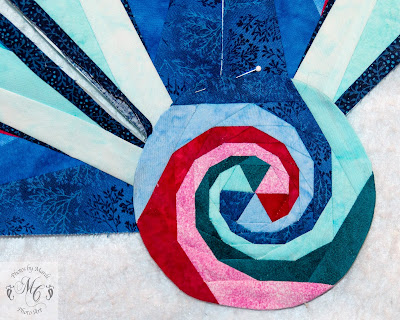I designed my new quilt on Adobe Illustrator and then used the computer to stretch the drawing a bit here and there. My previous spirals have mostly been mandalas, or circles. Check the G
allery. This one will be new, fresh and different. It is almost a little modern, but since I love curves and curlicues I will do a bunch of those when I quilt, so not so modern after all.
The first spiral is long and skinny so the paper patterns have to be taped together as they can't be printed on 8.5 x 11 inch Sulky Paper Solvy. I thought surgical paper tape was the perfect answer, but my old tape globbed up the presser foot. I bought a new roll, but sadly discovered that it does the same thing. Maybe it would work if I put it on the back of the paper, but I gave up and went back to plain old scotch tape. I have had no problems since. I sure wasted a lot of time on that idea!!
TIP: Go ahead and try your ideas. Sometimes they work, but sometimes they don't. Oh well, the world continues to turn either way.
 |
| Pattern printed in three pieces shown cut apart. |
 |
| Taped-together spiral pattern with fabric sewn to it. |
I chose to use solid colors with the support of two of my biggest fans. I bought all the Kona solids that I would need, sat down and started sewing. Unfortunately, the result was so flat and uninteresting and the gradations left something to be desired (my bad). At that point I lost my momentum. This can happen when you design your own quilts, as I do. None of the complications have been addressed and solved by others. After a day or two I went to my fabric stash and pulled a bunch of prints that would give me the gradations I needed in three colors. I will use 3 or 4 of the solid fabrics as well. My tester sample looks so nice, warm, friendly and vibrant compared to the one with solids only. Now I am excited to work on it again.
 |
Patterned fabric on left; solid fabric on right
(piecing incomplete - one more ring to be added) |
TIP: If you lose your momentum it may be because you are not happy with the results. Give it a little time, and think about what else you might do to recover the excitement. Something inside will tell you when it is right. Even when discouraging things happen, I still turn back to sewing. It truly is my therapy.
It has been awhile since I have done a spiral and I was immediately reminded of how important it is to get the points right. That means sharp, smooth and in exactly the right place. If they don't hit exactly right it is well worth your time to redo them immediately. Later on you won't be able to get in there to do a fix.
 |
| Circle denote places where points are critical. |
 |
| Good points!! They are each nestled perfectly into the corner. |
Why did your point miss the mark?
- The previous fabric was not pressed tightly back at the seam, which left a tiny pleat over the stitching.
- Your stitching got away from the sewing line on the pattern.
- The fabric had a wrinkle that you didn't catch.
- God's finger got in the way!
Usually the problem is easily fixed. Take out the stitching carefully trying not to tear the paper for about an inch over the offending point. Using tweezers pull the point fabric in line and glue it. Make sure it makes a straight line. If it wants to curve, tear out a few more stitches of the point fabric as well as the covering fabric and try again. Lay the covering fabric over the point, check it, glue it, stitch it.
TIP: Use Elmer's School glue, which is harmless, doesn't show when dry, and washes completely out.
If the problem is a poorly pressed seam you might have to take out more of the stitching so you can re-press the offending part of the seam and try again. You have to work very carefully to keep the paper intact, but if it tears, just tape it together with scotch tape - carefully.
Sew a happy seam this week. I wish you perfect points.




























